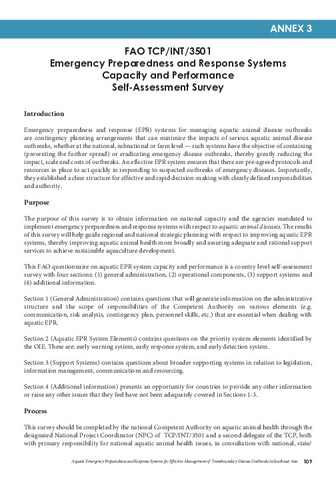Management of fishing capacity for sustainable fisheries: RPOA-capacity

រកមើល / បើក
Downloads: 491
កាលបរិច្ឆេទ
2016Page views
664ទិន្នន័យមេតា
មើលកំណត់ត្រាលម្អិតនៃធាតុ
Share
អរូបី
The increasing demand for fish prompts many fishers with highly-equipped fishing boats, to unceasingly chase for fish oblivious of the impacts of any irresponsible operations on the resources. The uncontrolled exploitation of the fishery resources ends up with overcapacity, which in turn lures fishers to engage in illegal fishing operations resulting in overfishing, and ultimately to resources depletion. Under such a scenario, the task of managing the fishery resources on a sustainable basis has become increasingly challenging, and the immeasurable threats of over-exploitation and degradation of aquatic habitats have become serious problems, especially in the Southeast Asian region. Recognizing that overfishing and overcapacity seriously threaten the sustainable management and conservation of fishery resources, and the severity of such problems, the Ministers of the ASEAN-SEAFDEC Member Countries responsible for fisheries through the Resolution and Plan of Action on Sustainable Fisheries for Food Security for the ASEAN Region Towards 2020, had resolved to promote better management of fishing capacity and the use of responsible fishing technologies and practices. Specifically, such agreement led to recognition and movement towards the replacement of the 'open access' to fisheries resources with "limited access" through rights-based fisheries as well as to secure the rights and well-being of inland and coastal fisheries communities. As a leading regional organization working towards the promotion of sustainable fisheries management and countermeasures to combat IUU fishing in the Southeast Asian region, SEAFDEC has exerted continuous efforts to address this serious issue. Through series of consultations organized by SEAFDEC with funding support from the Japanese Trust Fund and the SEAFDEC-Sweden Project, the SEAFDEC Member Countries came up with a draft Regional Plan of Action for the Management of Fishing Capacity (RPOA-Capacity) to serve as management tool and voluntary guidelines for preventing over-exploitation of the fishery resources and consequently combating IUU fishing in the region.
Suggested Citation
Amornpiyakrit, T., & Siriraksophon, S. (2016). Management of fishing capacity for sustainable fisheries: RPOA-capacity. Fish for the People , 14(2), 18-23. http://hdl.handle.net/20.500.12066/991
ប្រធានបទ
បណ្តុំបណ្តុំ
Related items
Showing items related by title, author, creator and subject.
-
Beyond capacity adaptation – for what should it be adapted?
Hagberg, Jacob (Secretariat, Southeast Asian Fisheries Development Center, 2018)It is well known that keeping fish stocks at optimum stock sizes will increase the production of fish leading to larger profits for fishers and increased food production. The Southeast Asian countries have started to make ... -
Koi Herpesvirus – A new threat to fish culture: Mobilizing Southeast Asian capacity
Nagasawa, Kazuya (Secretariat, Southeast Asian Fisheries Development Center, 2004)Koi herpesvirus (KHV) is a new pathogen in Southeast Asia, where its infection was first detected in common and koi carps (Cyprinus carpio) from Indonesia in March 2002. Since then, in Indonesia there have been numerous ... -
FAO TCP/INT/3501: Emergency preparedness and response systems capacity and performance self-assessment survey
Tendencia, Eleonor A.; de la Peña, Leobert D.; de la Cruz, Joesyl Marie V.; FAO (Aquaculture Department, Southeast Asian Fisheries Development Center, 2019)The purpose of this survey is to obtain information on national capacity and the agencies mandated to implement emergency preparedness and response systems with respect to aquatic animal diseases. The results of this survey ...




